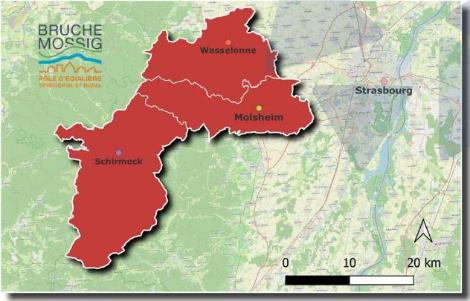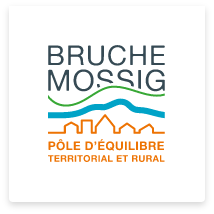The Bruche-Mossig region and the development of a mobility strategy
January 2023
Association Nationale des Pôles territoriaux et des Pays (ANPP - Territoires de projet)
As a young territory, the Pays de Bruche-Mossig Pôle d’Équilibre Territoriale et Rural (PETR) has carried out intensive diagnostic work with a view to drawing up its mobility strategy. This strategy is closely linked to the Pays’ strategic documents, whether the territorial project or regulatory and planning documents such as the PCAET or the SCoT.
To download : enquete-mobilite-1.pdf (1.9 MiB)

Each of the three communities of communes making up the PETR is the organising authority for mobility within its area, a choice resulting from a regional desire. However, by supporting them, the PETR plays an important role in the implementation of this remit. Transport initiatives in the region are supported by the region, the département, the intercommunal bodies and the PETR. The latter is particularly active in the field of car-sharing. The bureau of its trade union committee represents a privileged forum for exchange between mobility players, where negotiations take place and decisions are made in this area. In this way, the PETR acts as an umbrella organisation on this issue. The intercommunal bodies are present at the mobility COPIL and COTECH meetings, and the meeting of their DGSs is the forum for technical decision-making. This is an opportunity to explain and discuss the issues and bring them to the attention of the EPCIs. Emphasis is also placed on consultation with stakeholders, and local authorities are represented in the webinars dealing with this subject. This dynamic is reflected in the management of the Climate Plan, which aims to move from a « transport » perspective to a « mobility » approach that is more cross-functional and includes all stakeholders. Drawing up the strategy The theme of mobility can be found in the structuring documents of this recently created project area - the prefectoral decree creating the PETR was issued on 23 July 2019 - whose territorial project is currently being drawn up. It is based in particular on the SCoT and the PCAET, which take account of mobility issues.
To define the mobility strategy, an analysis of all modes of transport was carried out. Antoine MONTENON, who is responsible for mobility issues, describes it as « a complete review of knowledge about the area ». This is necessary in order to define the strategy and actions of the PETR and the EPCIs, and to avoid being guided by unsubstantiated representations of the area. The Bruche-Mossig PETR is structured by a TER line linking it to Strasbourg, Sélestat and Schirmeck, and by a BHNS line linking it to Strasbourg from Wasselonne. However, the car remains the dominant form of transport in this very rural area. It accounts for 70% of journeys, 78% of which are self-propelled. Car-pooling accounts for no more than 1% of journeys. Although the diagnosis shows that there are two main employment areas - Molsheim, the most populous commune in the region, and the Strasbourg metropolis - it also highlights the attractiveness of the region’s central towns, compared with those outside the PETR, contrary to common perceptions. While home/work journeys account for a maximum of 30% of trips, their attractiveness is also linked to the presence of services and leisure facilities. This diagnosis not only provides a current knowledge base of the area, but also aims to project its development to 2050, in order to guide the strategies of the PETR and the AOMs over this timeframe. The key issues identified are
-
Improving rail transport, by ensuring the continuity of the service and its legibility beyond the Strasbourg-Molsheim corridor
-
Linking the BRT with other modes of transport, as well as the frequency of evening services, in order to adapt to certain uses, particularly leisure activities
-
The safety and signage of cycle lanes
-
Getting people to and from bus stops and stations, as car use is exacerbated by the difficulty of accessing these facilities
-
Access to employment areas
Based on this diagnosis, an action plan has been drawn up, involving the PETR, the EPCIs, the region and the département. Each point sets out the challenges of the action, those involved and its cost. The PETR’s action focuses in particular on short-distance car-sharing, in order to democratise and promote its use. The aim is to work with local businesses to encourage home-to-work journeys, and with local authorities on home-to-services journeys. Communication on good practice is at the heart of the action, and the car-sharing system is common to all three EPCIs. To carry out this mission, the PETR has been partially delegated responsibility. A number of funds have been mobilised for this action, including subsidies from France Mobilité, as well as departmental funds for the study. Consultation of the parties involved in such an action is necessary. To this end, the PETR is working with small businesses, local associations and local residents. Ultimately, the PETR is seen as a facilitator and a centre of expertise. By bringing together the various players in the area working on this and related issues, it reduces the number of contacts, for the regional authorities for example. Those involved in employment also see the PETR as a privileged interlocutor and provider of solutions. The experience of the Pays de Bruche-Mossig illustrates the fundamentals of the implementation of mobility competence, whether exercised directly by the PETR or by its members. On the one hand, it is a question of producing precise knowledge of the area, beyond common representations. To this end, the diagnostic study provides an overview of the data on the area, enabling a well-founded representation to be forged, on which to build a strategy that responds to concrete issues. On the other hand, a multitude of players are active in the field of mobility. Coordinating them and meeting the many needs expressed - interconnection of living and employment areas, access to services and leisure activities, etc. - requires areas for consultation, discussion and joint management. The Pays level is particularly relevant in this field, at the interface between the political and administrative levels and their stakeholders.
